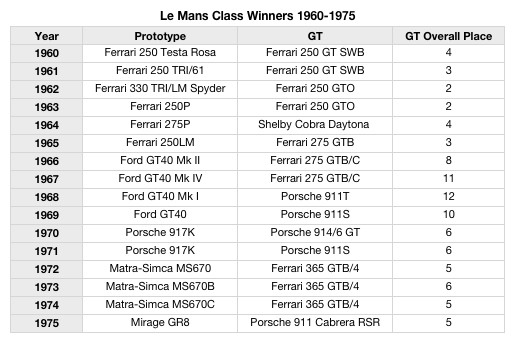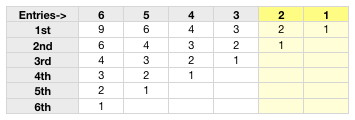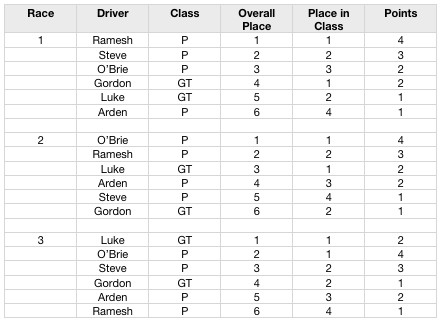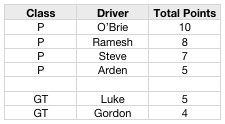Some thoughts on our Vintage Sports '60-'75 class for 2018
Posted: Sat Oct 28, 2017 12:27 pm
We currently include both our Prototype and GT cars into the VS6075 class. Because both categories are running with the same regulations, sometimes a Prototype car wins and other times a GT car wins. In the real world this almost never occurs because these are really two classes running simultaneously, with the Prototypes running to higher-performance specs. Here are the winning Le Mans class results for the period covered by our class:

As you'll notice, a GT car has never won Le Mans during this period, the highest place being 2nd overall on two occasions.
Being a stickler for having our racing as realistic as possible, I have some regulation change proposals for 2018 to differentiate the performance of the two sub-classes and therefore make the them more realistic. Here are my thoughts (non-performance changes shown in green; performance-related changes shown in blue):
Vintage Sports Prototype '60-'75 (VSP6075)
For slightly modified slot models of racing prototype cars from 1960 to 1975 - see Eligible Cars below.
For slightly modified slot models of racing GT cars from 1960 to 1975 - see Eligible Cars below.
Option 1:
Run two sets of races, one for each class. On the down side, this adds one more qualifying session and three more races to the event.
Option 2:
Run the classes concurrently, giving separate points for each class. These points can be based on an updated version of the standard point system, shown in yellow below (races are really never done for fewer than three cars, so this acommodates running the classes concurrently; we can use this system for all classes from 2018 to keep things simple):

This allows us to maintain just three races for VS6075. Here are some example results and points totals:


In this example O'Brie wins the Prototype class and Luke wins the GT class. Of course points will change dependant on the number of entries in each sub-class and their finishing places.
So, let's hear your thoughts.

As you'll notice, a GT car has never won Le Mans during this period, the highest place being 2nd overall on two occasions.
Being a stickler for having our racing as realistic as possible, I have some regulation change proposals for 2018 to differentiate the performance of the two sub-classes and therefore make the them more realistic. Here are my thoughts (non-performance changes shown in green; performance-related changes shown in blue):
Vintage Sports Prototype '60-'75 (VSP6075)
For slightly modified slot models of racing prototype cars from 1960 to 1975 - see Eligible Cars below.
- Period: 1960-1975.
- Body: See Eligible Cars below. Body must comply with General item 2. Windows may not be tinted - interior must be visible.
- Chassis: Free, however angle-winder chassis or angle-winder pods are prohibited.
- Interior: May be modified to allow fitting of electronic components. It can be substituted by at least a full shelf with driver head, arms, steering-wheel and roll bar/cage. These items must be painted to appear like the original. Ultra-light/one-piece plastic interiors are not allowed. Must comply with General item 3.
- Digital Chip: Free.
- Motor: 22,500 RPM or lower, based on manufacturer's specifications.
- Gearing: Motor and axle gears may be changed.
- Motor Pod (where applicable): Angle-winder pods are prohibited.
- Magnets: USD rule. Magnets must be positioned at least 40mm ahead of rear axle. (This corresponds to the front magnet location on Slot.It motor pods.)
- Wheels: As close as possible to standard diameter for the particular model but may be substituted. Wheel inserts that match or are close to original wheel design are required.
- Axles: Free.
- Tyres: Free.
- Guide Flag: Free.
- Minimum Weight: 77gm.
For slightly modified slot models of racing GT cars from 1960 to 1975 - see Eligible Cars below.
- Period: 1960-1975.
- Body: See Eligible Cars below. Body must comply with General item 2. Windows may not be tinted - interior must be visible.
- Chassis: Free, however angle-winder chassis or angle-winder pods are prohibited.
- Interior: May be modified to allow fitting of electronic components. It can be substituted by at least a full shelf with driver head, arms, steering-wheel and roll bar/cage. These items must be painted to appear like the original. Ultra-light/one-piece plastic interiors are not allowed. Must comply with General item 3.
- Digital Chip: Free.
- Motor: 18,000 RPM or lower, based on manufacturer's specifications.
- Gearing: Motor and axle gears may be changed.
- Motor Pod (where applicable): Angle-winder pods are prohibited.
- Magnets: USD rule. Magnets must be positioned at least 40mm ahead of rear axle. (This corresponds to the front magnet location on Slot.It motor pods.)
Wheels: As close as possible to standard diameter for the particular model but may be substituted. Wheel inserts that match or are close to original wheel design are required. - Axles: Free.
- Tyres: Free.
- Guide Flag: Free.
- Minimum Weight: 90gm.
Option 1:
Run two sets of races, one for each class. On the down side, this adds one more qualifying session and three more races to the event.
Option 2:
Run the classes concurrently, giving separate points for each class. These points can be based on an updated version of the standard point system, shown in yellow below (races are really never done for fewer than three cars, so this acommodates running the classes concurrently; we can use this system for all classes from 2018 to keep things simple):

This allows us to maintain just three races for VS6075. Here are some example results and points totals:


In this example O'Brie wins the Prototype class and Luke wins the GT class. Of course points will change dependant on the number of entries in each sub-class and their finishing places.
So, let's hear your thoughts.